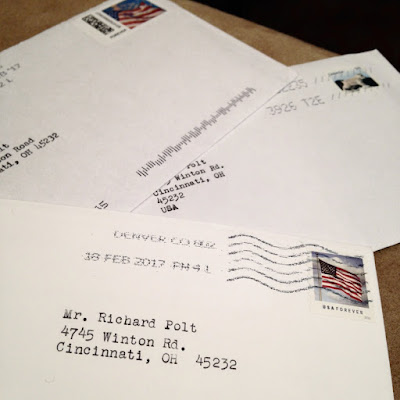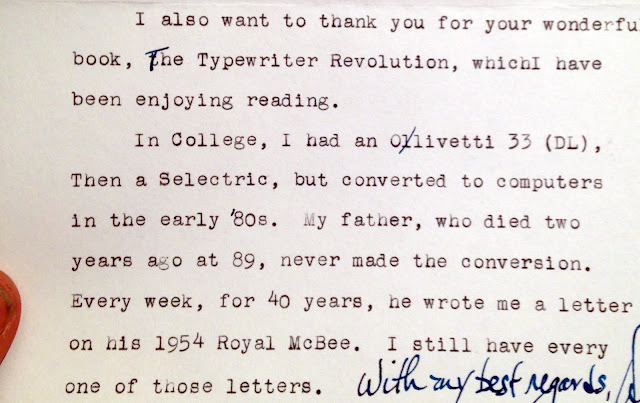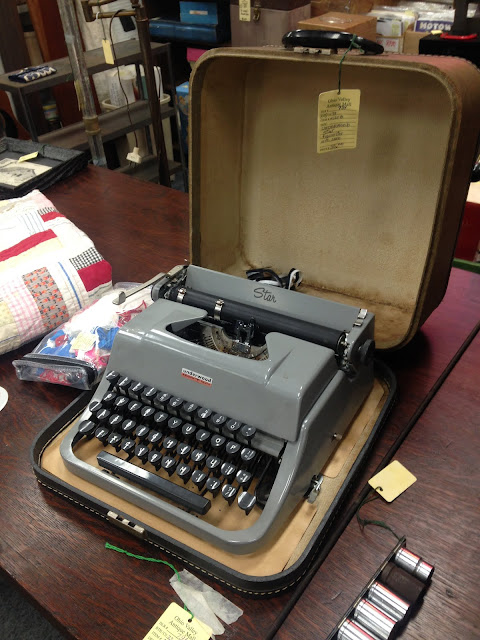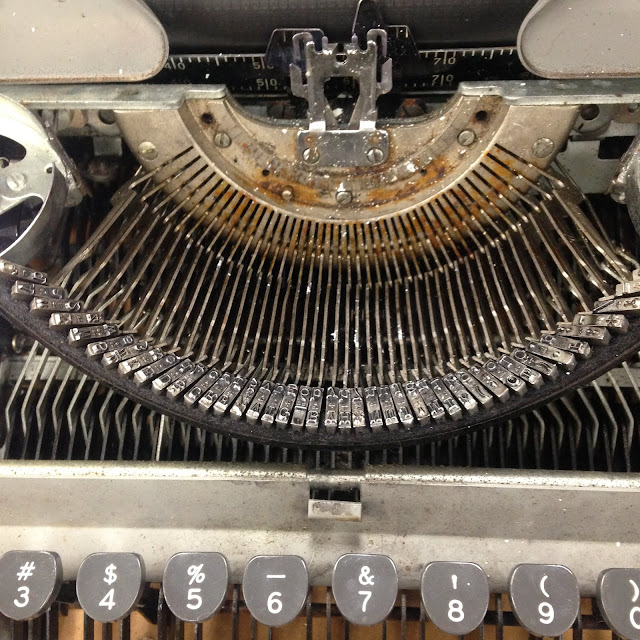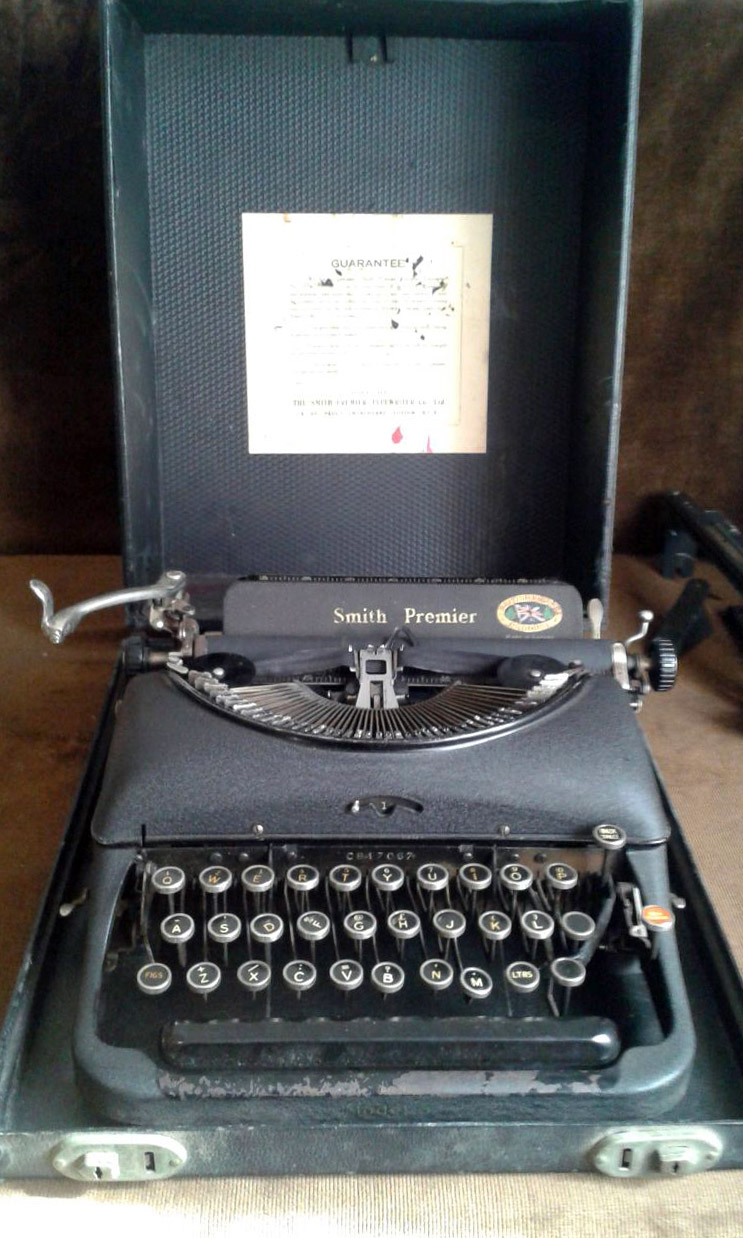Most typewriter collectors have heard of "mills." I believe there was a period when the term "mill" was occasionally used as slang to mean any typewriter, but the term was eventually restricted to the world of telegraphy. Before the rise of the teletype, the typical telegram required a telegraph operator to listen to Morse code and transcribe the message onto paper. Any typewriter could be used for the purpose, but a specialized "mill" used sans-serif capital letters only. Some mills have identical shifted and non-shifted letters (both are capitals). Others have no shifted character at all, or a tilde (~) for every shifted character. Some mills do not have shift keys at all.
The most commonly found mills are Underwoods that were made especially for Western Union and are distinguished by a red front panel. Their serial numbers begin with WU. (Note: none of the typewriters shown on this post are in my collection; I have just seen the photos online or they have been shared with me by e-mail.)
Here's an example of a message that seems to have been transcribed on a mill.

With the rise of automatic teletype equipment, starting around 1915, most telegrams bypassed the typewriter. Teletypes usually printed on a strip of paper that was then cut and pasted onto a telegram form.

But teletypes did not make mills completely unnecessary, and they continued to be produced for some time. For more information on typewriters and telegraphy, see the excellent article by Peter Weil in
ETCetera no. 102.
Let's turn now to
portable mills, and in particular, a very strange machine created by Remington.
You will occasionally find an ordinary-looking portable that turns out to be a mill. Some of them are marked as military property, like this U.S. Navy Remington Deluxe no. 5.
Then there are the weirder portable mills, which are mechanically different from ordinary typewriters.
Smith-Corona made a few in the 1930s and 1940s. Note that these machines have only three rows of keys and a correspondingly reduced number of typebars. Each key can print either a capital letter or a figure (numeral or punctuation mark). These typewriters look as if they have two space bars and no shift keys. My guess is that one of these bars is a real space bar, and the other is for shifting. The crinkle-painted machines below are marked Typewriter Telegraph No. something, and at least one of them was made in Canada.

The serial number on the machine below is 2S 85422 8A:
2023 addendum: collector Ben Metzger owns this
Gabe Burbano owns this Typewriter Telegraph No. 3B. Note that this machine has FIG and LTRS keys for shifting and unshifting. The LTRS key is just to the right of the M key.
Gabe has also kindly provided this picture of a row of Corona portable mills in use.
Here's a postwar portable mill made by Olympia, based on an SM3 model. Note the tray in back, maybe for holding telegram forms, and the two shift keys marked Zi (Ziffern, figures) and Bu (Buchstaben, letters). Presumably the carriage stays shifted when you push Zi, and returns to the unshifted position when you push Bu.


Here is a remarkable portable made by Remington, designed to type on a strip of paper. As if that weren't enough to mark it as a mill, it has no shift key.
Now to the machine that provoked this post. The following pictures were sent to me by a correspondent in South Africa. The typewriter is labeled as a Smith Premier Model 5. Essentially, it is a Remington Deluxe Model 5 (the Smith Premier name was often used by Remington when selling its machines outside the United States). It was made in Canada and its serial number is CB17067. According to
our limited serial number information about Remingtons made outside the US, the CB series dates from 1939-1940.
The typewriter is in a case with a guarantee that suggests that it was sold in London during the Second World War. Note, however, that the serial number listed on the guarantee is CB 169XX, lower than the number of this machine.
The typewriter has only three rows of keys, but note the stubs of levers for what would have been the fourth row.
Despite its reduced number of keys, the typewriter has a full complement of typebars. There are 28 usable typebars and 14 unusable typebars, which are not connected to any keys. The unusable typebars have the following type slugs:
“
|
/
|
@
|
£
|
_
|
&
|
‘
|
(
|
?
|
)
|
1/4
|
%
|
1/8
|
5/8
|
2
|
3
|
4
|
5
|
6
|
7
|
8
|
9
|
,
|
-
|
3/4
|
1/2
|
3/8
|
7/8
|
On the right end, there is a typebar with no typeslug; another with a blank slug; and four with the typical fractions found on British typewriters. These last four typebars are among the unusable ones.
Let's look more closely at the keyboard:
Obviously, it is a mill. The typebars that can be activated are controlled by keys that print sans-serif capital letters in the unshifted position and figures in the shifted position. There is a FIGS key to raise the carriage, which stays up until you hit the LTRS key to lower it.
Note that the position of the LTRS key is just to the right of the M key, as on Gabe Burbano's Smith-Corona mill pictured above. The LTRS key is connected to a long, thick, diagonal lever.
To its right is a blank key, and and further to the right and up one row is another blank key. The first of these operates the typebar with no type slug, and the second one operates the typebar with a blank slug. The owner of the typewriter reports that these blank keys "kind of press on" the lever for the LTRS key, and speculates that their function may be "to lower the carriage and make a space in the same keystroke, thus saving time—why there are two of them I would not know."
So there you have it. Has anyone seen a typewriter just like this one before? Can anyone shed more light on its origin? I look forward to your ideas.
PS: For more pics of portable telegrapher's typewriters,
click here.
